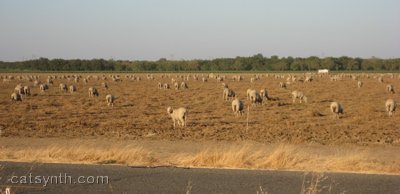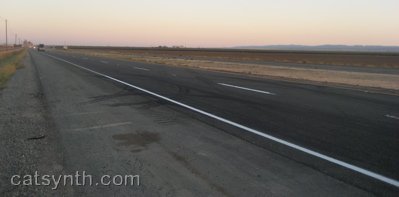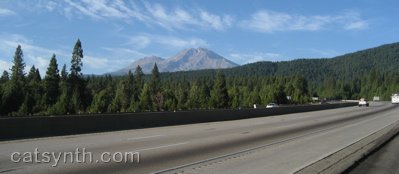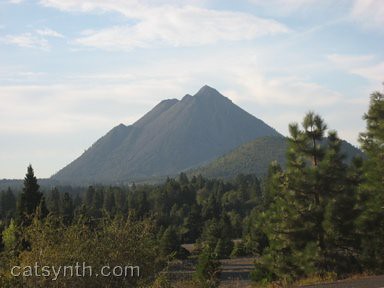As summer winds down, we start to look back the many little road adventures that dotted the season. The largest and last of these trips, of course, was to Portland, which included a large stretch of northern California.
We begin on I-505, which heads north from I-80, bypassing Sacramento.

.png) I-505 is a completely straight, flat, stretch of highway. This is pretty much true of the surrounding landscape as well, but the texture and details against this blank canvas can make for some interesting photos.
I-505 is a completely straight, flat, stretch of highway. This is pretty much true of the surrounding landscape as well, but the texture and details against this blank canvas can make for some interesting photos.

 I-505 merges into I-5, which continues northward through more of the relatively flat landscape, repeatedly crossing the Sacramento River in the process. Eventually we come to the city of Redding at the northern end of the Sacramento Valley. On my return trip from Portland, I finally had a chance to stop in Redding and visit the Sundial Bridge. This modernist architectural gem spans a wooded section of the Sacramento River completely, a world apart from the town of Redding itself or the strip malls and shopping centers that line the highways. Here, clean modern lines contrast with the natural forms of trees and running water.
I-505 merges into I-5, which continues northward through more of the relatively flat landscape, repeatedly crossing the Sacramento River in the process. Eventually we come to the city of Redding at the northern end of the Sacramento Valley. On my return trip from Portland, I finally had a chance to stop in Redding and visit the Sundial Bridge. This modernist architectural gem spans a wooded section of the Sacramento River completely, a world apart from the town of Redding itself or the strip malls and shopping centers that line the highways. Here, clean modern lines contrast with the natural forms of trees and running water.


The Sundial Bridge turned out to be a great subject for abstract photography (you can see another shot in an earlier Wordless Wednesday). It was also quite crowded with families and groups, something to keep in mind should I ever want to use it as a setting for a more formal photo shoot.
North of Redding, I-5 climbs into the southern Cascades towards Mount Shasta. The highway here is quite scenic, but also narrow, winding, and treacherous. Eventually it opens up as one passes Mount Shasta and approaches Black Butte.

Black Butte is a satellite cone of Mount Shasta. It has a distinctive pointy shape and largely barren rocky texture, both of which make it quite prominent in the landscape. The highway curves around its edge, providing a close-up view.


 After passing Mount Shasta and Black Butte, I-5 descends into a wide valley, passing by the town of Weed, whose welcome sign is a popular backdrop for photographs. This is the start of US 97, which heads northeast towards Klamath Falls and central Oregon as I-5 continues due north through the Cascades towards Portland. The main street in Weed is also Historic US 99. The part of the historic route which returns to I-5 is now California Highway 265, one of the shortest in the system.
After passing Mount Shasta and Black Butte, I-5 descends into a wide valley, passing by the town of Weed, whose welcome sign is a popular backdrop for photographs. This is the start of US 97, which heads northeast towards Klamath Falls and central Oregon as I-5 continues due north through the Cascades towards Portland. The main street in Weed is also Historic US 99. The part of the historic route which returns to I-5 is now California Highway 265, one of the shortest in the system.


From here, the valley descends and opens further, and the landscape becomes surprisingly desert-like. We pass the town of Yreka, where I did not get a chance to stop, but might on a future trip because of some idiosyncratic road-geek things. Finally, the highway climbs upwards again towards Siskiyou Summit, just north of the Oregon-California border and the highest point on all of I-5 at 4,310 feet (1,310 meters).

 The segment of this trip is along I-80, crossing the Bay Bridge and north through Berkeley into the towns of the “North Bay” that always seemed remote even when I was lived in the area. I-80 crosses over the
The segment of this trip is along I-80, crossing the Bay Bridge and north through Berkeley into the towns of the “North Bay” that always seemed remote even when I was lived in the area. I-80 crosses over the .png)


 I-505 soon rejoins the main I-5 freeway coming north from Sacramento towards the Oregon border. Somehow, I-5 manages to appear even flatter than 505:
I-505 soon rejoins the main I-5 freeway coming north from Sacramento towards the Oregon border. Somehow, I-5 manages to appear even flatter than 505:











